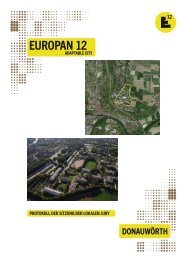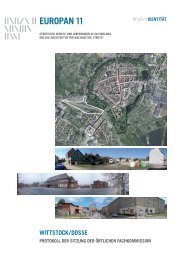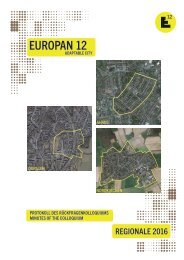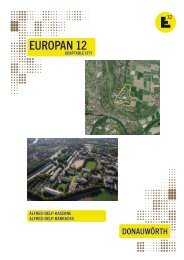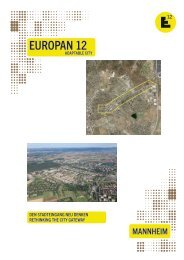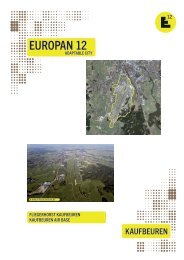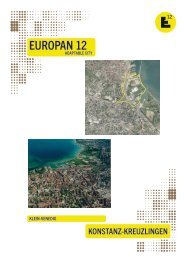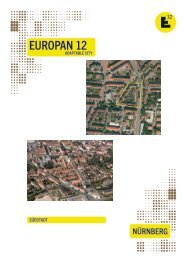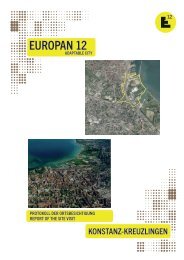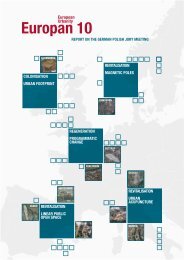Auslobung Bitterfeld-Wolfen - EUROPAN Deutschland
Auslobung Bitterfeld-Wolfen - EUROPAN Deutschland
Auslobung Bitterfeld-Wolfen - EUROPAN Deutschland
Sie wollen auch ein ePaper? Erhöhen Sie die Reichweite Ihrer Titel.
YUMPU macht aus Druck-PDFs automatisch weboptimierte ePaper, die Google liebt.
BITTERFELD-WOLFEN<br />
Abbildung 2 - Luftbild Figure 2 – Aerial photograph<br />
Quelle: Landesamt für Geoinformation Source: Regional Office for Geoinformation<br />
Die Stadt entstand als planmäßige Straßenmarktanlage.<br />
Die Befestigung des kleinen Marktfleckens beschränkte<br />
sich auf einen Stadtwall und Wassergräben, weshalb<br />
er im Dreißigjährigen Krieg leicht einzunehmen war.<br />
Nahezu völlig zerstört fiel <strong>Bitterfeld</strong> zeitweise wüst und<br />
wurde nur noch sporadisch bewohnt. Dank der Lage am<br />
Muldeübergang der alten Handelsstraße von Halle nach<br />
Wittenberg gelegen, wurde es jedoch wieder aufgebaut.<br />
Seine wirtschaftlichen Grundlagen bildeten zunä chst<br />
Handel, Landwirtschaft, Handwerk und Braukunst. Die<br />
Stadt gehörte lange Zeit zu Sachsen und wurde erst<br />
1815 der preußischen Provinz Sachsen zugeschlagen.<br />
Dagegen blieb der Norden bis 1945 ein Teil von Anhalt.<br />
Bis heute hat sich diese alte Grenze in der Zugehörigkeit<br />
der Kirchgemeinden zu den Evangelischen Kirchen Mitteldeutschlands<br />
bzw. zur Landeskirche Anhalt erhalten.<br />
Braunkohle und darüber liegende Tonschichten waren<br />
die Grundlagen für einen ersten wirtschaftlichen Aufstieg<br />
um 1840: die Produktion von Ziegelsteinen, dem gelben<br />
„Greppiner Klinker“. Er prägt bis heute das Gesicht vieler<br />
Gebäude in <strong>Bitterfeld</strong>-<strong>Wolfen</strong> und fand auch europaweit<br />
z. B. beim Bau großer Bahnhöfe Verwendung. Von nun<br />
an mehrten sich die Nachrichten über die <strong>Bitterfeld</strong>er<br />
Region, die sich in einem rasanten Tempo, vor allem<br />
ab 1893, dem Gründungsjahr der ersten Elektrochemischen<br />
Werke durch die AEG, zu einem bedeutenden<br />
Industriegebiet entwickelte. Der junge Walther Rathenau<br />
sammelte hier Erfahrungen als Industrieller. Wenige Jahre<br />
später sollte er noch einmal als führender Organisator<br />
der deutschen Kriegswirtschaft maßgeblichen Einfluss<br />
auf die Entwicklung Mitteldeutschlands nehmen. 1894<br />
ging die erste großtechnische Chloralkalielektrolyse in<br />
Betrieb. Chlor- und Elektrochemie bestimmten fortan die<br />
The town was built as a linear street market place.<br />
Teil 2<br />
The fortifications of the small market town only consisted<br />
of a town wall and water trenches, which made<br />
it easy prey in the Thirty Year’s War. Almost completely<br />
destroyed, <strong>Bitterfeld</strong> became quite deserted, with some<br />
inhabitants only living there sporadically. Thanks to its location<br />
on the Mulde river crossing on the old trade route<br />
from Halle to Wittenberg however, the town was rebuilt.<br />
Initially, its commercial foundations were trade, agriculture,<br />
crafts and the brewing business. The town belonged<br />
to Saxony for a long time and only became a part of the<br />
Prussian province of Saxony in 1815. However, the north<br />
remained a part of Anhalt until 1945. This old border is<br />
still evident as the local parishes belong to the Protestant<br />
Churches of Central Germany and/or the Regional<br />
Church of Anhalt.<br />
Lignite and layers of clay above it were the basis for a first<br />
economic upswing around 1840, triggered by the production<br />
of bricks, the so-called yellow “Greppin Klinker”.<br />
This has shaped the face of many buildings in <strong>Bitterfeld</strong>-<strong>Wolfen</strong><br />
until the present day, and the bricks were<br />
used to build large railway stations in the whole of Europe.<br />
From there on, the <strong>Bitterfeld</strong> region became increasingly<br />
known. It developed into an important industrial area at a<br />
rapid pace, in particular from 1893 onwards, the year in<br />
which the electrochemical plants were founded by AEG.<br />
The young Walter Rathenau gained experience here as an<br />
industrialist. A few years later, Rathenau again considerably<br />
influenced the development of the Central German<br />
region as he became the leading organiser of the German<br />
war economy. In 1894, the first technical chlorine-alkali<br />
electrolysis went into operation on a large industrial scale.<br />
From there on, the chlorine and electrochemical in-<br />
18



